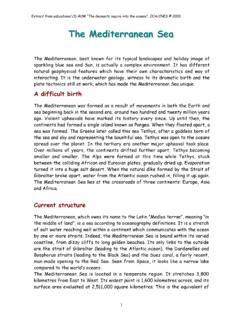Transcription of The Mediterranean Sea - oca.eu
1 Extract from educational CD-ROM The Geonauts inquire into the oceans , OCA/CNES 2000. The Mediterranean Sea The Mediterranean , best known for its typical landscapes and holiday image of sparkling blue sea and Sun, is actually a complex environment. It has different natural geophysical features which have their own characteristics and way of interacting. It is the underwater geology, witness to its dramatic birth and the plate tectonics still at work, which has made the Mediterranean Sea unique. A difficult birth The Mediterranean was formed as a result of movements in both the Earth and sea beginning back in the second era, around two hundred and twenty million years ago. Violent upheavals have marked its history every since. Up until then, the continents had formed a single island known as Pangea. When they floated apart, a sea was formed. The Greeks later called this sea Tethys, after a goddess born of the sea and sky and representing the bountiful sea. Tethys was open to the oceans spread over the planet.
2 In the tertiary era another major upheaval took place. Over millions of years, the continents drifted further apart, Tethys becoming smaller and smaller. The Alps were formed at this time while Tethys, stuck between the colliding African and Eurasian plates, gradually dried up. Evaporation turned it into a huge salt desert. When the natural dike formed by the Strait of Gibraltar broke apart, water from the Atlantic ocean rushed in, filling it up again. The Mediterranean Sea lies at the crossroads of three continents: Europe, Asia and Africa. Current structure The Mediterranean , which owes its name to the Latin Medius terrae , meaning in the middle of land , is a sea according to oceanography definitions. It is a stretch of salt water reaching well within a continent which communicates with the ocean by one or more straits. Indeed, the Mediterranean Sea is bound within its varied coastline, from dizzy cliffs to long golden beaches. Its only links to the outside are the strait of Gibraltar (leading to the Atlantic ocean), the Dardanelles and Bosphorus straits (leading to the Black Sea) and the Suez canal, a fairly recent, man-made opening to the Red Sea.
3 Seen from Space, it looks like a narrow lake compared to the world's oceans. The Mediterranean Sea is located in a temperate region. It stretches 3,800. kilometres from East to West. Its widest point is 1,600 kilometres across, and its surface area evaluated at 2,511,000 square kilometres. This is the equivalent of 1. Extract from educational CD-ROM The Geonauts inquire into the oceans , OCA/CNES 2000. 5 times the whole of France, or % of the total surface area of the world's oceans. With a volume of 3,700,000 cubic kilometres, it would submerge the whole of France under 7 kilometres of water. It is fed by several major rivers, the most important being the Po (Italy), the Rhone (France), the Ebre (Spain) and the Nile (Egypt). The Mediterranean is a very deep sea 1,500 metres on average. Its plunging abysses can lie next to soaring cliffs rising abruptly out of the sea. Snow-capped Alpine peaks over 3,000 metres high lie within a mere 50 kilometres of the shore. The Mediterranean Sea is formed by several other seas or basins, the most important of which are the Adriatic Sea, the Aegean Sea, the Tyrrhenian Sea, the Algerian-Provence basin, the Ionian basin and the Levantine basin.
4 Its coastline stretches around 46,000 kilometres, which shows the close link between sea and land (40 % of this shoreline is around islands). Some of these islands are quite big and have marked relief. Among these are Corsica, Sardinia, Sicily, the Balearic islands, Crete, Cyprus and Rhodes. Each is a small continent in its own right, with its own climate, fauna and flora. Their geological composition is very variable, depending on their origins. Chaos on the Mediterranean Sea bed The Mediterranean Sea is nestled in a gash in the Earth's surface. Under the surface of the water, the sea bed's contours reveal this fact. The sea bed actually looks just like the surrounding land, with its contrasting and complicated relief. There are deep basins where the sea bed has collapsed, separated by high walls. Stretching from West to East, its western side opens out into the Atlantic south of Spain through the shallow Strait of Gibraltar (less than 320 metres deep). To the east, it opens out into the Black Sea by the Dardanelles (less than 200 metres deep) and Bosphorus straits (less than 50 metres deep).
5 There are two main basins, the western and the eastern basin: The western basin South of Spain, the western basin is composed of the Alboran Sea, which is the beginning of the large abyssal plain covering the whole central part of the Mediterranean and Tyrrhenian Seas and descending to over 3,500 metres at certain points. These great depths characterize the western basin, often deeper than 2,500 metres, even close to the shore. This is the case along the Algerian coastline, part of the French coastline (Provence and Alpes-Maritimes) and around Corsica. 2. Extract from educational CD-ROM The Geonauts inquire into the oceans , OCA/CNES 2000. The eastern basin The eastern basin is longer and deeper. The deepest part of the Mediterranean Sea is the 5121 metres of the Matapan trench in the Ionian Sea, south of Peloponniso. This makes it even deeper than the faults in the Atlantic ocean. The eastern basin has a bigger continental shelf than the western basin, mainly in the Adriatic and Aegean Seas.
6 The south-eastern edge of the biggest basin (Levantine) runs alongside the continental shelf off the mouth of the Nile, north of Egypt. Sea currents and water masses Seen from the beach in summer, the Mediterranean Sea usually looks like a big lake, occasionally upset by storms or wind. The truth is that circulation in the Mediterranean is very active both at surface level and deeper down. It is also specific to the Mediterranean . Basin geometry The Mediterranean is known as a partly-closed sea as it only has one narrow, shallow passage (the Strait of Gibraltar) linking it to the world's oceans. This feature, along with the Mediterranean basin's division into several different sub- basins such as the Adriatic, Tyrrhenian or Ionian Seas which are themselves separated by straits (Sicily, Otranto and the Corsican channel, to name but three), plays a major role on the currents, temperature and salinity of the water. Climatic conditions The climate is mainly characterized by hot, dry summers and relatively temperate, wet winters except for various regions in the south and south east which have an arid, even desert climate.
7 The combination of strong winds and an arid climate results in intense evaporation which, averaged over the basin, causes a deficit of water that is not fully compensated by rainfall or rivers. The Mediterranean is said to be an evaporation basin . About 3 million tonnes of water are evaporated every year (the rough equivalent of a layer of water 1 metre deep over the whole of the basin), whereas rainfall only contributes one million tonnes of water per year. It is the water from the Atlantic ocean, flowing through the Strait of Gibraltar, that keeps the water mass constant. What is more, evaporation causes an excess of salt in the remaining water. This salty water is heavy, so it sinks down. It is the flow of heavy, salty water leaving through the Strait of Gibraltar which ensures that the percentage of salt in the basin remains constant. 3. Extract from educational CD-ROM The Geonauts inquire into the oceans , OCA/CNES 2000. Transformation of Atlantic water into Mediterranean water.
8 The circulation in the Mediterranean may be likened to an engine which transforms the lightly salted Atlantic water entering through the Strait of Gibraltar into a dense, salty water known as Mediterranean water which in turn leaves through the Strait of Gibraltar into the North Atlantic. Map of surface currents compiled by H. Lacombe and P. Tchernia The Atlantic water entering the Mediterranean near the surface flows alongside Africa at a depth of 100 to 200 metres. The Algerian current, as it is known, is very unstable, creating meanders which then form eddies. At the Sicily Strait, the water splits into two branches. One deviates north, entering the Tyrrhenian Sea along the Italian coastline. It continues its journey towards the Ligurian Sea where it forms the Ligurian-Provence current, which shadows the Italian coastline then the French coastline off Nice and the Gulf of Lions then the Catalonian coastline before entering the Balearic Sea where it becomes unstable.
9 The other branch heads eastward through the Strait of Sicily, crosses the Ionian basin then reaches the Levantine basin. The latter's arid climate increases the water's salinity through evaporation. As this salty water is denser, it is also heavier so sinks to the bottom. At the Strait of Sicily, this intermediate mass of Levantine water heads towards the Tyrrhenian Sea, following first the Italian then the French and finally Spanish coastlines until it reaches the Strait of Gibraltar. As it travels, its characteristics change as it mixes with surrounding water. The high salt content (around 39 grams per litre) that it acquires when formed gradually drops. 4. Extract from educational CD-ROM The Geonauts inquire into the oceans , OCA/CNES 2000. The deep vein of water in the Eastern basin is a mixture of deep water formed in the Adriatic and Aegean Seas. It is characterized by a temperature below 14 C. In the Ligurian Sea and the Gulf of Lions, it mixes with a very dense mass of water which forms during the winter.
10 This dense water is due to atmospheric cooling (leading to a drop in sea temperature) and the Mistral wind, causing massive evaporation and therefore an increase in salinity of the surface zone. The very dense water masses formed in this way are known as the deep water of the Western Mediterranean . The temperature of these water masses lies around C and their salinity around grams per litre. It is therefore a mixture of this deep water and Intermediate Levantine water which flows out along the bottom of the Strait of Gibraltar. We can track these water masses in the North Atlantic because of their high salt content, so we can see how they are dispersed. Most of the Mediterranean vein of water heads up along the Portuguese coastline. The Mediterranean water's salt content is a major influence on circulation in the Atlantic. Variability of currents over time Variations may occur within a week, a season or over several years and may lead to considerable differences compared with the circulation described above.






